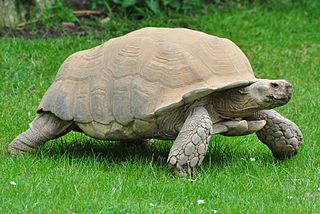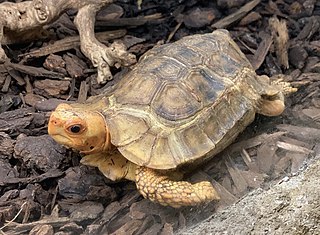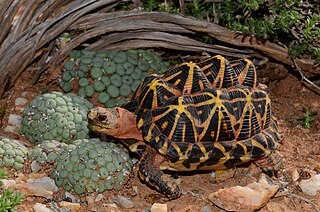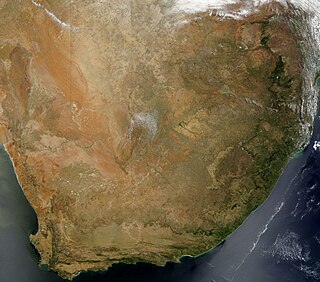
Tortoises are reptiles of the family Testudinidae of the order Testudines. Like other turtles, tortoises have a shell to protect from predation and other threats. The shell in tortoises is generally hard, and like other members of the suborder Cryptodira, they retract their necks and heads directly backward into the shell to protect them.

The honey badger, also known as the ratel, is a mammal widely distributed in Africa, Southwest Asia, and the Indian subcontinent. Because of its wide range and occurrence in a variety of habitats, it is listed as Least Concern on the IUCN Red List.

The African spurred tortoise, also called the sulcata tortoise, is an endangered species of tortoise inhabiting the southern edge of the Sahara Desert, the Sahel, in Africa. It is the largest mainland species of tortoise in the world, and the third-largest in the world, after the Galapagos tortoise and Aldabra giant tortoise. It is the only living species in its genus, Centrochelys, with the five other species in the family already extinct.

The leopard tortoise is a large and attractively marked tortoise found in the savannas of eastern and southern Africa, from Sudan to the southern Cape Province. It is the only extant member of the genus Stigmochelys, although in the past, it was commonly placed in Geochelone. This tortoise is a grazing species that favors semiarid, thorny to grassland habitats. In both very hot and very cold weather, it may dwell in abandoned fox, jackal, or aardvark burrows. The leopard tortoise does not dig other than to make nests in which to lay eggs. Given its propensity for grassland habitats, it grazes extensively upon mixed grasses. It also favors succulents and thistles.

Chersobius signatus is the world's smallest species of tortoise. The species is commonly known as the speckled tortoise and also known locally as the speckled padloper and internationally as the speckled Cape tortoise. A member of the genus Chersobius, it is endemic to South Africa.

The geometric tortoise is a critically endangered species of tortoise and one of three members of the genus Psammobates. It is found in a very small section in the South-Western Cape of South Africa.

The acacia tit, also known as the Somali tit and northern grey tit, is a species of bird in the family Paridae. It is native to north eastern Africa where it occurs in dry acacia habitat.

Homopus is a genus of tiny tortoises in the family Testudinidae, endemic to southern Africa. Three species have been moved to the genus Chersobius.

The forest hinge-back tortoise, also known commonly as the serrated hinge-back tortoise or Schweigger's tortoise, is a species of tortoise in the family Testudinidae. The species is indigenous to the tropical forests and marshes of central and western Africa.

The East African black mud turtle, also known as the Pan terrapin, is a species of turtle in the family Pelomedusidae, native to eastern and southeastern Africa.

Bell's hinge-back tortoise, also known commonly as Bell's eastern hinged tortoise, is a species of tortoise in the family Testudinidae. The species is native to central Africa. It has the hinge that characterizes all tortoises in the genus Kinixys. There are no recognized subspecies.

The angulate tortoise is a species of tortoise found in dry areas and coastal scrub vegetation in South Africa. This tortoise is the only known member of the genus Chersina.

The serrated tortoise German: Kalahari-Strahlenschildkröte is a species of tortoise that occurs in the Kalahari desert regions of southern Africa. Also known as the Kalahari tent tortoise, it is one of three members of the genus, Psammobates.

The tent tortoise is a species of tortoise and one of three members of the genus, Psammobates. Known locally as the Karoo tent tortoise, this highly variable species is found in South Africa and Namibia.

Homopus femoralis, commonly known as the greater padloper, is a small tortoise of the genus Homopus, indigenous to the highveld grasslands of South Africa.

Chersobius boulengeri, commonly known as the Karoo padloper or Boulenger's cape tortoise, is a species of tortoise in the family Testudinidae. The species is endemic to the Nama Karoo Region of South Africa.

The fauna of South Africa is diverse and largely typical of the ecosystems in Africa. South Africa is ranked sixth out of the world's 17 megadiverse countries. Many endemic species are unique to South Africa. The country is among the world leaders in conservation, but at the time wildlife is threatened by poaching and canned hunting.

The Turtle Conservancy (TC) is a conservation organization that aims to protect endangered turtles, tortoises, and their habitats worldwide.
John L. Behler was an American naturalist, herpetologist, author, and activist known for his work in conserving endangered species of turtles, snakes, and other reptiles. He served as curator of herpetology at the Bronx Zoo, part of the Wildlife Conservation Society from 1976 to 2006. He co-chaired the IUCN Tortoise and Freshwater Turtle Specialist Group, and was a founding member of the Turtle Survival Alliance, which co-present the Behler Turtle Conservation Award with the Turtle Conservancy and Turtle Conservation Fund. The Behler Turtle Conservation Award is a major annual award to honor leadership in the field of freshwater turtle and tortoise conservation. The Turtle Conservancy named its captive breeding center, the Behler Chelonian Center, in his honor.

Chersobius is a genus of tiny tortoises in the family Testudinidae, endemic to southern Africa. The genus includes the smallest tortoises in the world. All three species were previously assigned to the genus Homopus.




















